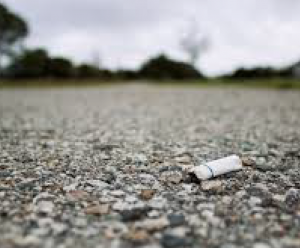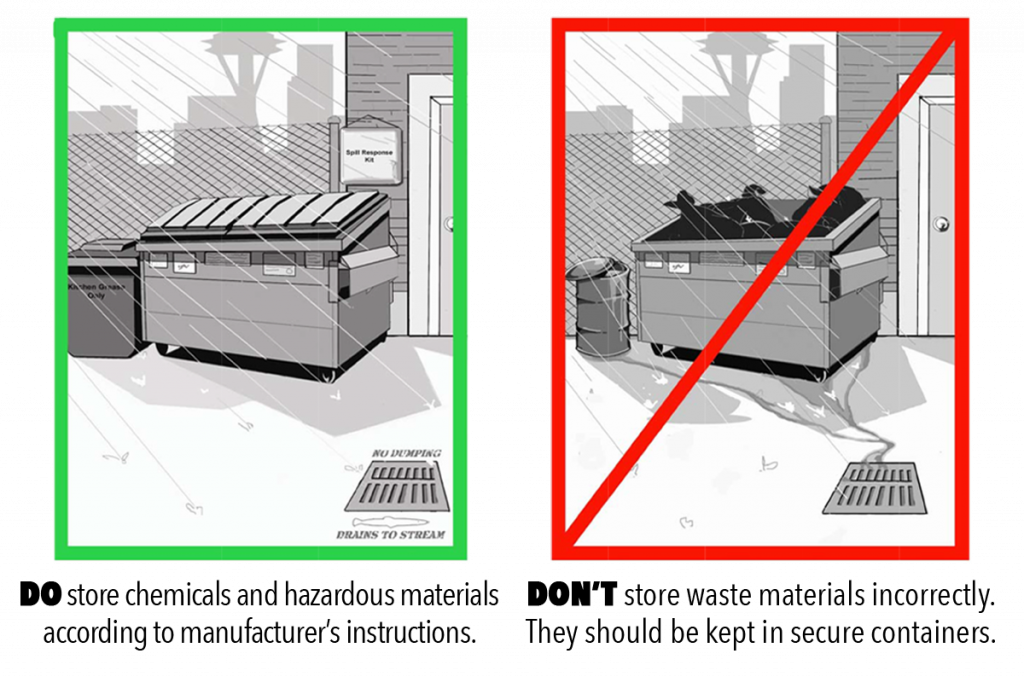Pollution Prevention for Outdoor Areas
Stormwater is rain or snowmelt that flows over the ground. As stormwater runs over impervious surfaces like driveways, roofs, sidewalks, and streets; it can pick up pollutants that have collected on these surfaces – such as motor oil, fertilizers, pesticides, and trash – and allow them to flow into stormwater catch basins. Stormwater flows into the storm drain system and is discharged without treatment into local waterways.
Property owners are responsible and liable for all pollutants leaving their property. This includes stormwater that enters the storm drain, also known as catch basins, that is contaminated. Common pollutants generated by businesses such as automotive and food and beverage establishments include used motor oil, antifreeze, fertilizers and pesticides, sand, dirt, litter, paint, cooking oil, and cigarette butts.
Recommended Practices for Cleaning & Maintaining Outdoor Areas
Most of the Best Management Practices (BMPs) identified below are non-structural and cost little or nothing to implement. This listing is not all-inclusive and other non-structural and structural BMPs can be implemented to further reduce the potential of contributing to stormwater pollution.
Parking Lot, Loading Docks & Delivery Areas
Do
- Reduce the build-up of contaminants by regularly cleaning these areas.
- Sweep and remove all dirt, debris, and trash using a broom, blower, vacuum truck or sweeping machine.
- Clean up all visible oil deposits using absorbent materials.
- Properly dispose of used absorbent materials.
- If water is required, use as little as possible and do so without detergents.
- Prior to cleaning these areas using water or detergents, seal all storm water inlets in all potentially affected areas.
Don’t
- Allow dirt and oil to accumulate on or penetrate into the pavement.
- Pressure wash or use water to clean parking areas without first sweeping and removing all of the surface debris and trash.
- Pressure wash or use water to clean parking areas without spot-cleaning oil-stained areas.
- Pile spent or contained absorbent materials on the ground or dispose of this in a dumpster.
- Use an excess of water as the primary method of cleaning or use detergents unnecessarily.
- Allow wash water generated from cleaning parking and delivery areas to flow into the stormwater system.
Dumpster & Trash Compactor Areas
Do
- Inspect dumpster storage and trash compactor areas daily.
- Replace or repair leaky dumpsters.
- Keep dumpster lids closed.
- Have enough dumpster storage space and evaluate or increase the frequency of service.
- Dispose of food waste through a garbage disposal or bag and seal this waste before placing it in a dumpster.
- Minimize disposing of liquids in dumpsters and compactors.
- Sweep up trash regularly and use absorbent materials to clean up liquid spills and liquids draining from dumpsters or compactors.
- Locate trash compactors in an area surrounded by a berm and plumbed into an approved sanitary sewer drain connection.
- Prior to cleaning trash storage areas using water or detergents, seal all storm water inlets in all potentially affected areas.
Don’t
- Pile trash around full dumpsters or allow trash liquids to enter the stormwater system.
- Ignore leaks by frequently cleaning up after leaking dumpsters using a hose and water.
- Allow rain to fall into open dumpsters.
- Allow dumpsters to be overfilled or stack trash on the ground around full dumpsters.
- Dispose of open containers of food directly into a dumpster or allow it to be spilled around the disposal areas.
- Drain liquids from waste containers before disposing of them in dumpsters/compactors.
- Pressure wash or use water to clean up liquids spills or allow trash leachate to enter the stormwater system.
- Allow wash water to generate from cleaning trash storage areas to flow into the stormwater system.
Sidewalk, Plaza & Building Areas
Do
- Clean sidewalks and plaza areas frequently using a broom or blower and use dry absorbent materials to clean up spills. Dispose of spent adsorbent materials properly.
- If water is required to clean sidewalks and plaza areas, utilize low-water use cleaning devices. Use detergents only if necessary.
- Contain all wash water when cleaning painted building or wall surfaces that are peeling or flaking or may contain heavy metals.
- Always seal all storm water inlets near affected areas prior to cleaning outdoor surfaces using any cleaning additives.
- Always seal storm water inlets near affected areas when cleaning outdoor eating areas using water only or cleaning additives.
Don’t
- Allow trash, dirt and debris to build up in these areas or spray down areas where a spill has occurred with water and a hose.
- Pressure wash or use water as a primary approach to cleaning sidewalk and plaza areas or use detergents if conditions are not warranted.
- Allow paint particles or heavy metals (i.e. painted surfaces prior to 1980) from building wash water to enter the stormwater system.
- Allow detergents, cleansers, solvents, acid wash runoff, or any other cleaning additives to enter the stormwater system.
- Allow wash water containing food particles, grease, oil or detergents to enter the stormwater system.
Staff Training
Do
- Train staff on proper spill cleanup and reporting procedures.
- Label and identify to staff all on-site stormwater inlet locations.
- Designate selected staff members to conduct inspections of impervious surfaces and stormwater structures.
- Maintain records detailing the maintenance of all on-site stormwater structures.
- Post a listing of Best Management Practices where all staff can view for reference.
Don’t
- Assume your staff knows these procedures without the proper training.
- Expect your staff to know which drains lead to the stormwater system.
- Assume that since one staff member has done this in the past that these structures are being monitored.
- Expect your Staff to remember the proper ways of cleaning and handling waste.
 Collection and Disposing of Waste Wash Water from Cleaning Outdoor Areas
Collection and Disposing of Waste Wash Water from Cleaning Outdoor Areas
Discharges to landscape areas (only those that were not designed in part or in whole to store stormwater discharges), to any approved sanitary sewer connection, or contained for proper off-site disposal.
- Sidewalk and Plaza Areas (no outdoor eating areas; no cleaning additives)
- Building Surfaces (no peeling paint; no heavy metal paints; no cleaning additives)
Discharges to any approved sanitary sewer connection or contained for proper off-site disposal.
- Sidewalk and Plaza Areas (no outdoor eating areas; using non-hazardous cleaning additives)
- Building Surfaces (no peeling paint; no heavy metal paints, using non-hazardous cleaning additives)
Discharges to an approved sanitary sewer connection equipped with appropriate pretreatment devices (oil / water separators or interceptors, sediment traps, etc.) or contained for proper off-site disposal.
- Sidewalk and Plaza Areas (with outdoor eating areas; with or without non-hazardous cleaning additives).
- Parking Lot and Delivery Areas (with or without non-hazardous cleaning additives)
- Dumpster and Compactor Areas (with or without non-hazardous cleaning additives)
Discharges that must be contained for proper off-site disposal (booms, pumps, tanks, pump trucks, etc.).
- Any surfaces cleaned using solvents or any other potentially hazardous or flammable additives.
- Building Surfaces (with peeling paint; surfaces containing heavy metal paints; using hazardous additives)
Notes
Use containment devices and pump the wash water to an approved sanitary sewer connection if one is not installed nearby.
Hire a licensed contractor and require / maintain proper disposal documentation.

